Regional election in Cantabria, 28 May 2023

Jonatan García Rabadán
Professor of sociology at the University of the Basque CountyIssue
Issue #4Auteurs
Jonatan García Rabadán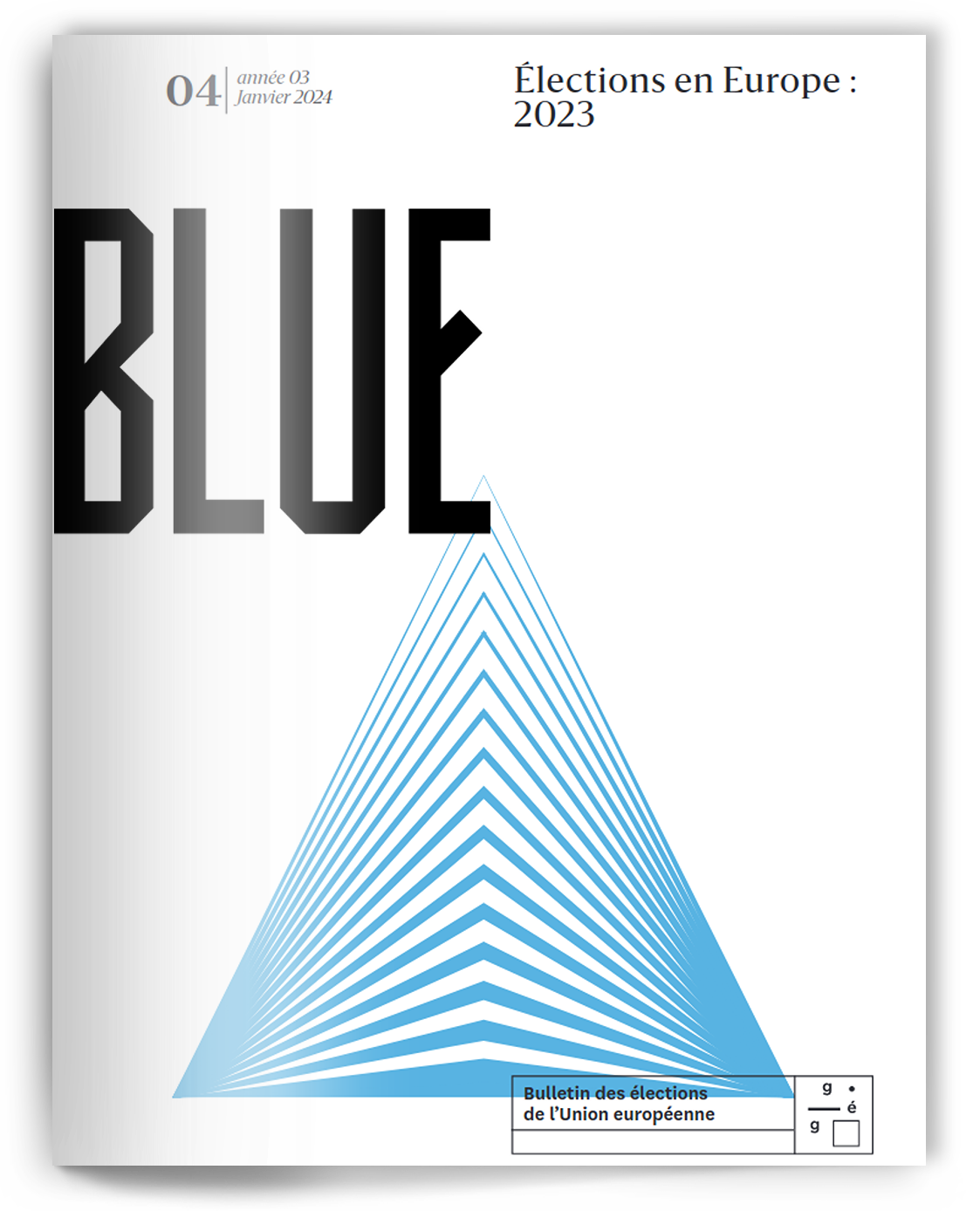
Issue 4, January 2024
Elections in Europe: 2023
On May 28, municipal and regional elections were held in Spain. Among the 12 Autonomous Communities that were to renew their Parliament was Cantabria. Since the approval of its Statute of Autonomy in 1981, the northern community has developed its own political and party system, including the existence of a regionalist party, the PRC, which occupies a pivotal position on the regional political spectrum (García Rabadán, 2019). The PRC has been part of the regional executive on multiple occasions, forming part of coalition governments with PSC-PSOE or PP. The 2023 election however has seen a halt in the growth of Cantabrian regionalism, with a victory of the PP (35.8% of the votes and 15 seats) and the rise of Cantabrian socialism (PSC-PSOE). While these results can be directly linked to the influence of political competition at national level, the disclosure of alleged corruption cases within the regional Department of Public Works — directed by a PRC official — and the subsequent resignation of the department’s head is also likely to have affected the electoral outcome.
Cantabria as an Autonomous Community within Spain
With the approval of the 1978 Spanish Constitution and the onset of what would become contemporary Spain’s decentralized state model, multiple territories claimed political recognition as Autonomous Communities (Pérez Castaños and García Rabadán, 2018). Cantabria was one of them, despite initial plans placing it within the territory of Castilla y León. It was not without difficulty that a strong pro-autonomy movement able to secure the region a statute of its own (Bar Cendón, 1995; Ramos Rollón, 1998).
Currently, according to data from the National Institute of Statistics of 2023 (January 1), Cantabria has just over 588,000 inhabitants, with half of the population concentrated in four municipalities and their urban areas: Santander (171,693 inhabitants), Torrelavega (51,142), Castro Urdiales (33,109) and Camargo (30,374) 1 . Nevertheless, the community is made up of a total of 102 municipalities, and rural areas and the primary sector continue to play an important symbolic role in the region’s socio-political imaginary, including in tourism. This imaginary is to be connected with the process initiated by part of the governing Cantabrian regionalism in recent decades and especially by the hand of President Revilla (García Rabadán, 2019).
Normatively speaking, the Cantabrian electoral system follows the same guiding principles as the majority of Spanish regional electoral systems, with the main difference that the territory of Cantabria is not divided into provinces. The 35 seats in the Cantabrian Parliament are elected by direct universal suffrage through closed electoral lists in a single constituency, which is identical with the autonomous community itself. In addition, the system defines a threshold of 5% of the votes to participate in the distribution of seats. After more than four decades of regional political life, these characteristics have consolidated a system in which the formation of government coalitions has been recurrent. In the last decades, all of these coalitions have involved the parliamentary support of the PRC and its presence in government. However, historically, regionalism has not always been led by this political formation, since in the 90’s the breakup of the Partido Popular (PP) brought about the constitution of a regional alternative, the UPCA (Unión para el Progreso de Cantabria). The latter managed to take power in 1991 with the support of the PP. After two legislatures, the UPCA’s project was diluted, and the PRC took up the baton of regionalist sentiment once again.
The party competition in the 2023 regional election in Cantabria
As mentioned earlier, the elections of the 11th autonomous Cantabrian Legislature saw a victory of the PP who obtained almost 36% of the votes and 15 seats. At some distance, the second position is shared by the PRC and the PSC-PSOE, with just over 21% of the votes and 8 deputies each. Unlike in the last term, VOX (11.1% of the votes and 4 deputies) is the only other party represented in parliament, as the liberal party Ciudadanos (C’s) was left without representation after falling short of the electoral threshold (2.3%). The Podemos-IU coalition suffered a similar fate (4.1%), despite having had 3 deputies in the 9th Legislature (2015-2019).
Thus, the parties that have led the Cantabrian executive in the last two terms have not been able to command a sufficient majority to remain in office. The incumbent government’s defeat is mainly the result of a PRC counterperformance. The regionalist party lost more than 55,000 votes (-17 points of electoral support) and 6 representatives, while the PSC-PSOE managed to win more than 9,000 additional votes (+3 points) and 1 deputy. The outcome can hardly be explained by a change in turnout, as participation remained stable at 34.7% (compared to 34.3% in 2019). The results seem to point to a nationalization of the political competition in the region, likely caused by increased polarization and tensions in the Spanish electoral system. Together, the two main national parties (PP and PSOE) registered a 15-point increase in their vote share, from 41.6% in 2019 to 56.4% in this call.
Despite this scenario, the Cantabrian electoral offer of 2023 and that of 2019 are quite similar, both in terms of the number of parties and coalitions running for election and of their identity. Each of the dozen political forces that competed on May 28 can be classified as being either a National Party (NP) or a Regional Party (RP) 2 . The former obtained 27 deputies and 75.1% of the valid votes, while the latter obtained 8 deputies in the Cantabrian Parliament and 23.1% of the votes. For the regionalists, the 2023 election represents a break with the positive trend observed in the last decades. A champion of Cantabrian regionalism, the PRC had been consolidating its position as a key player in the Community’s governance system, forming government coalitions either with PP (1995-1999 and 1999-2003) or with PSOE (2007-2011, 2007-2011, 2015-2019 and 2019-2023). Its position allowed the PRC to hold the presidency of the region despite not being the largest political force, as occurred in the first three legislatures with the PSOE. The apex of the PRC’s cantabrismo was reached in 2019 when the municipal, autonomic, and general elections took place in the same year. In that electoral cycle, Revilla’s party not only reached the first position in most of the municipalities of Cantabria and in the regional parliament, but also sent its first deputy to the Spanish lower house, the Congress of Deputies.
The regionalist political offer in this election consisted of four different forces: Cantabristas, Ola Cantabria, Cantabria Distinta, and the PRC. This fragmentation does not coincide with an increase in overall regionalist influence. On the contrary, support for the Regionalist Party of Cantabria declined, and the party went from being the first force in 2019 to the second (tied with the PSOE) in 2023. The party led by Revilla concentrates 90% of the regionalist ballots and 100% of the regionalist seats.
The indices proposed by electoral sociologists and political scientists such as Rae (1971) or Laakso and Taagepera (1979), among others, allow for a quantitative analysis of political competition. Using the Effective Number of Parties (ENP), Fragmentation, and Volatility — all of which are computed from the parties’ shares of votes and seats –, the reconfiguration of the autonomic electoral competition in Cantabria can be appreciated. The electoral ENP grows from 4.15 to 4.4, indicating a moderately higher degree of electoral competition. This limited increase, however, is not reflected in the allocation of seats. Within the legislature, the ENP decreases to 3.3 (from 3.6 in 2019), due mainly to the disappearance of C’s. A related index is the degree of fragmentation which grows in votes (from 0.76 to 0.77), but decreases in seats (from 0.72 to 0.69). The sum of votes for the two biggest parties in 2023 is reduced to 56.7%, when in 2019 it stood at 61.7%.
In any case, the numbers still point to a high degree of competition. The analysis of political volatility yields a similar conclusion. Volatility quantifies voters’ loyalty on a scale of 0 to 100. In 2023, the volatility indicator stands at 22.55 in votes and 25.71 in seats. Following the classic typology by Sartori (2005), the Cantabrian party system can be classified as a moderate multiparty system, with a number of parties between three and five and executives formed on the basis of inter-party agreements.
The territorial factor in a single-province community
As the election takes place in a single constituency, the territorial distribution of the results needs to be analyzed in a more fine-grained way. The Popular Party won in most municipalities, among which the capital (40%) and two of the most populated cities (Torrelavega, 29.1% and Camargo, 38.5%). In Castro-Urdiales, the Socialist Party (PSC-PSOE) took the first position with 31.4% of the votes. This was the Socialists’ largest victory as the party won in only 6 other municipalities and tied with the PRC in one more (Tresviso). The second-largest party in terms per municipalities won is the PRC with more than twenty victories. Of these, it is worth mentioning the PRC’s 73% in Valle de Villaverde, both for the high support obtained and for the fact that Valle de Villaverde is a Cantabrian enclave within the Basque province of Bizkaia. The PP’s victory is not only the result of the urban electorate’s mobilization: support from rural areas has also been considerable. In contrast to what happened in the municipal elections 3 , these three political parties have been the only ones able to obtain the first position at the municipal level in the regional election. The Cantabrian electorate thus appears to have voted in a differentiated way at regional and local levels.
A comparison with the 2019 election shows the advance of the PP, but also of the PSC-PSOE. At that time, the two main national parties came in first in 22 municipalities (21 and 1, respectively). Again, this fact confirms the effect of Spain’s national political trends on the regional competition.

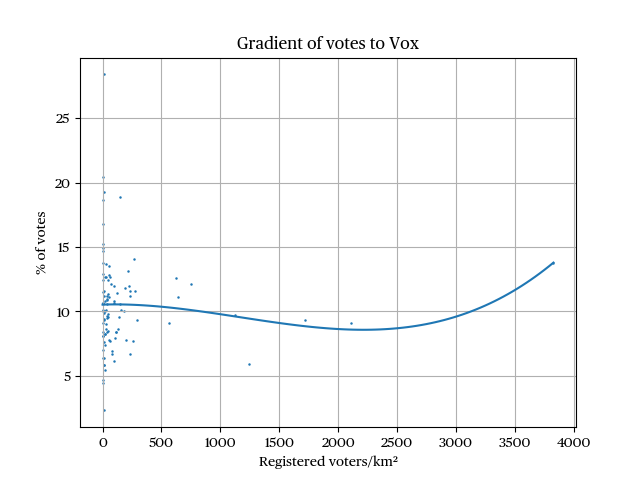
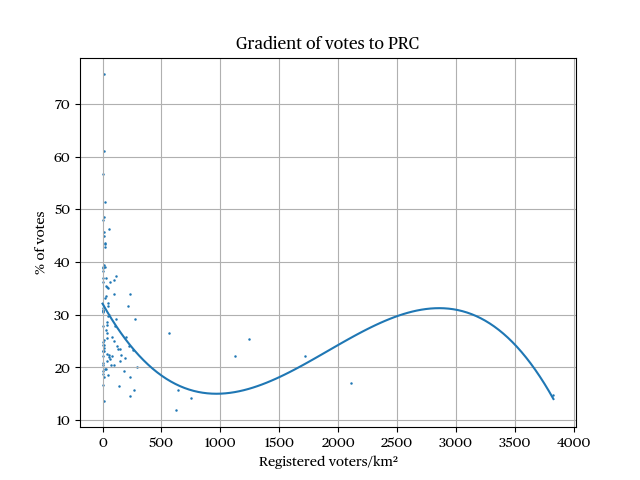
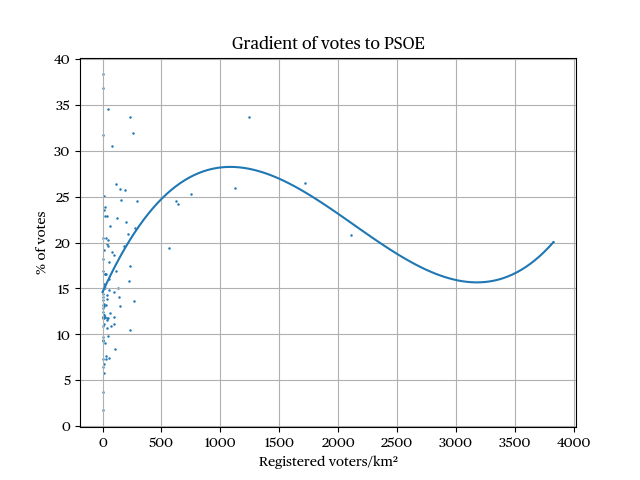
Analyzing the distribution of the vote of the four main political parties in Cantabria according to population density, several significant differences can be noted, which are consistent with the trends underlined in the previous paragraph. First, one can observes a difference between the national parties and the main regionalist party. The former enjoy stronger support in areas of highest population density, whereas rural areas are more favorable to Cantabrian regionalism. However, while the PRC obtains its best results (around 30%) in areas with a lower density, it recovers a similar level of support in semi-urban areas with 2,500 to 3,000 voters/km². This can also be seen in the map showing the winning party by municipality (see “the data”). However, in municipalities of all sizes, the degree of support for the PRC does not fall below 15%.
The vote shares of the national parties display different territorial patterns: support for the PP decreases with population density until a semi-urban reality begins to appear, while the opposite is true for the PSOE, whose percentage of support grows up to 1000 voters/km². In third place, the extreme right-wing VOX maintains a stable percentage of support close to 10% on average, reaching almost 15% in the highest-density areas.
Last but not least, the lead candidates’ influence on the campaign can be highlighted. Unlike other autonomous regions, Cantabria is known in Spanish politics for the role that President Revilla has been playing in different national media with his participation in high-audience programs, both political and entertainment-centered. The 1943-born politician is known by all the Cantabrian electorate (pre-electoral study CIS) and receives an average rating of 4.57. Behind him are PSOE candidate Pablo Zuloaga (90% of knowledge and a 4.5 rating) and PP candidate María José Sáenz de Buruaga (88% and a 4.44 rating). At the opposite end of the ranking, VOX lead candidate Leticia Díaz’s knowledge rate was only slightly above 50% (55.5%), and her rating was only a 3.4. Still, all lead candidates had a background in regional politics, having held different executive positions prior to the election.
Conclusion
In summary, the results of this election point to a change of political cycle in Cantabria or, at the very least, to a significant shift in the balance of forces. The national parties, especially the PP and PSOE, have increased their political momentum in the community, while the PRC lost votes and influence after decades of growth. Although institutional regionalism continues to play a “hinge” role, its electoral weight has diminished, as evidenced by its decision not to run in the general elections of July 23 and to abstain in the investiture vote 4 to prevent VOX from becoming a key player in the government formation process. The outcome of the election reproduces a scenario already observed in the aftermath of the 2011 election with a one-party PP government, albeit with a slight increase in political pluralism caused by the presence of VOX. The PRC and PSOE are in similar positions as in 2011, being unable to put togeter an absolute majority that would force the next government of José Sáenz de Buruaga to negotiate.
The data


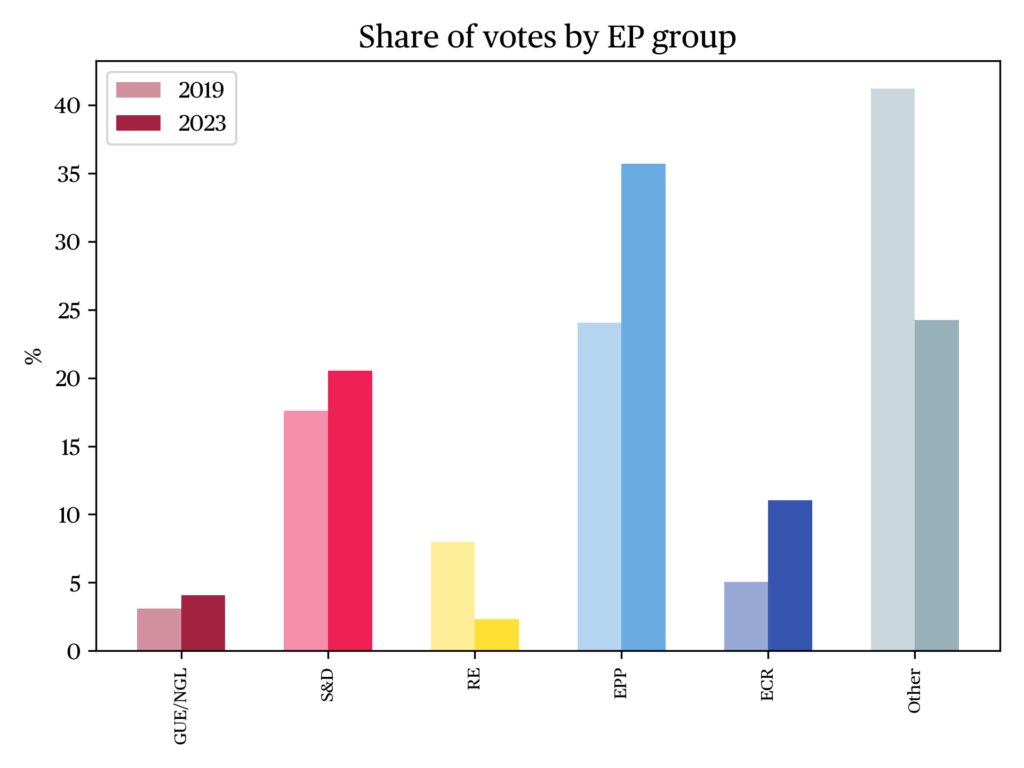
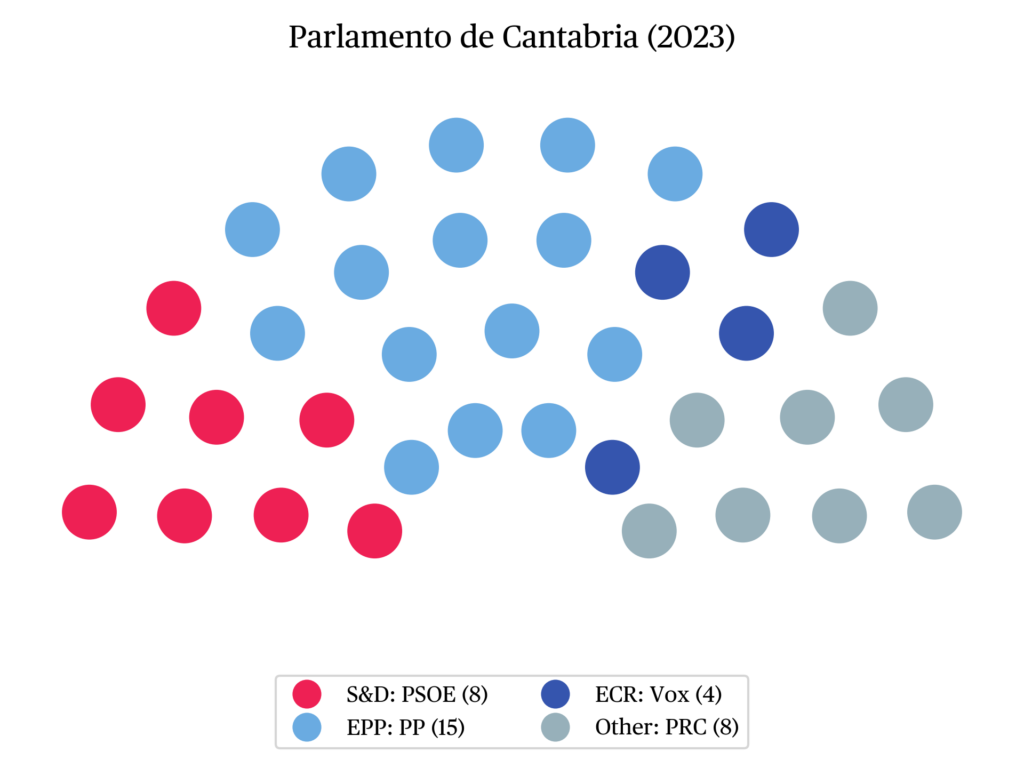
References
Bar Cendón, A. (1995). La comunidad autónoma de Cantabria: proyecto y realidad. In Suárez Cortina, M. (ed.), El perfil de “La Montaña”: economía, sociedad y política en la Cantabria contemporánea. Santander: Calima.
García Rabadán, J. (2022). Los partidos (II): las posiciones de los Partidos de Ámbito No Estatal (PANE). In Llera, F. J., N. Lagares, & J. Montabes (eds.) Las elecciones autonómicas (2017-2019). Madrid: Centro de Investigaciones Sociológicas.
García Rabadán, J. (2019). La competición política en Cantabria, 1983-2015: un regionalismo diferente para un tablero en convergencia. In Gómez Forte, B., S. Alonso Sáenz de Oger, & L. Cabeza Pérez (eds.), En busca del poder territorial: cuatro décadas de elecciones autonómicas en España (pp. 139-160). Madrid: Centro de Investigaciones Sociológicas.
Laakso, M. & Taagepera, R. (1979). Effective number of parties: a mesure with application to West Europe. Comparative Political Studies, 12: 3-27.
Martínez Fuentes, G. & García Rabadán, J. (2019). Conocimiento y valoración de los líderes políticos autonómicos. In Lagares, N., C. Ortega, & P. Oñate. Las elecciones autonómicas de 2015 y 2016 (pp. 81-98). Madrid: Centro de Investigaciones Sociológicas.
Pérez Castaños, S. & García Rabadán, J. (2018). Descentralización, Estado de las Autonomías y asimetría: 40 años de adaptación. In Bello Paredes, S. A. (dir.) 40 años de Constitución española: un análisis desde España e Iberoamérica (pp. 495-518). Cizur Menor: Thomson Reuters-Aranzadi.
Rae, D. W. (1971). The political consequences of electoral laws. New Haven: Yale University Press.
Ramos Rollón, L. (1998). Análisis de las elecciones autonómicas en Cantabria: el difícil proceso de creación de una autonomía. In Alcántara, M. & A. Martínez (eds.), Las elecciones autonómicas den España 1980-1997. Madrid: Centro de Investigaciones Sociológicas.
Ruiz Rodríguez, L. & Otero Felipe, P. (2013). Indicadores de partidos y sistema de partidos, Madrid: Centro de Investigaciones Sociológicas.
Sartori, G. (2005). Partidos y Sistemas de partidos. Marco para un análisis. Madrid: Alianza editorial.
Notes
- INE data for 2022.
- For further information on the role of the latter group of parties in Spanish regional politics, see: García Rabadán and Barberà (2022).
- In the municipal elections held on the same day, six other lists formed by local parties won the same number of municipalities.
- Public statement by the President of the PRC, Miguel Angel Revilla, on May 30.
citer l'article
Jonatan García Rabadán, Regional election in Cantabria, 28 May 2023, Jun 2024,
à lire dans cette issue
voir toute la revue





